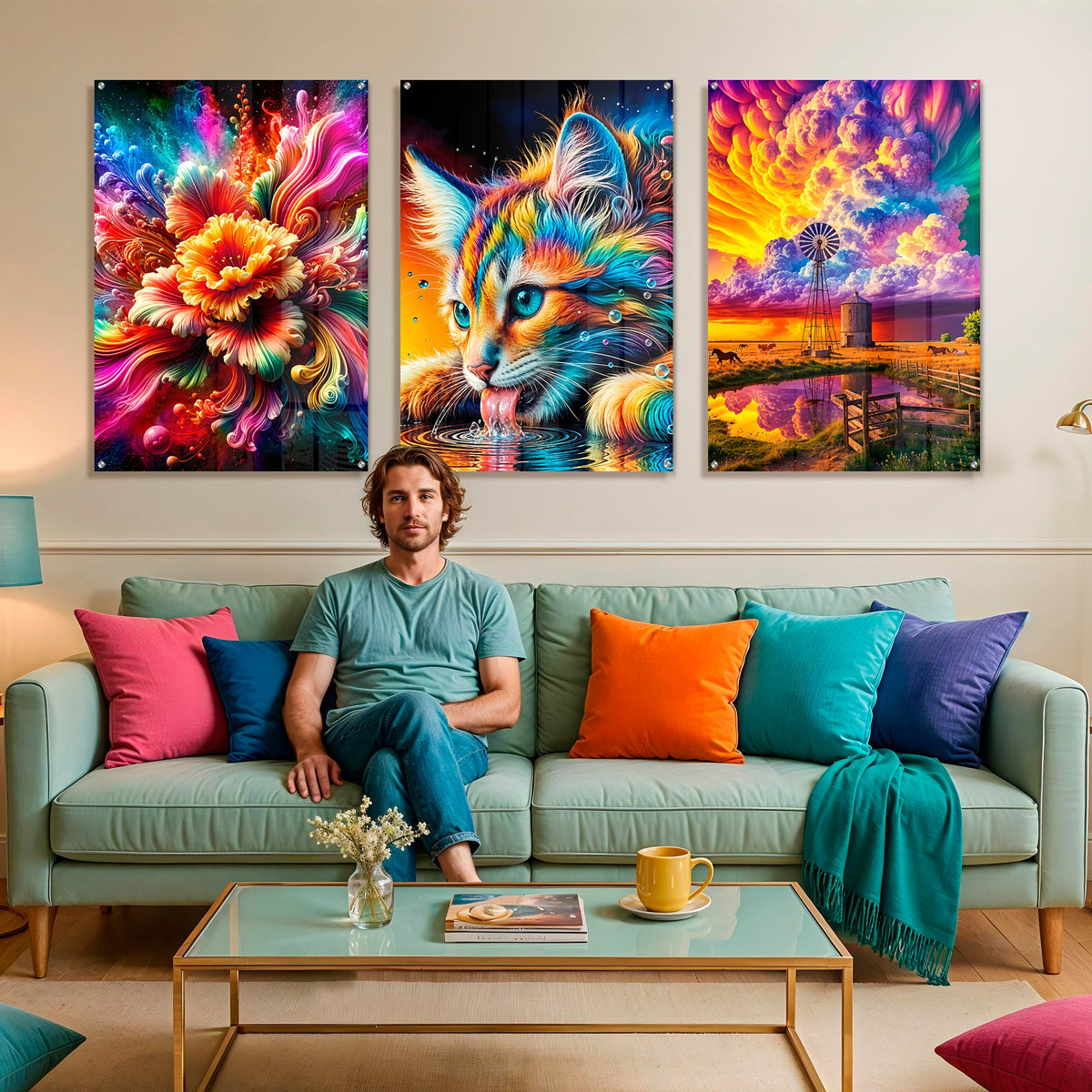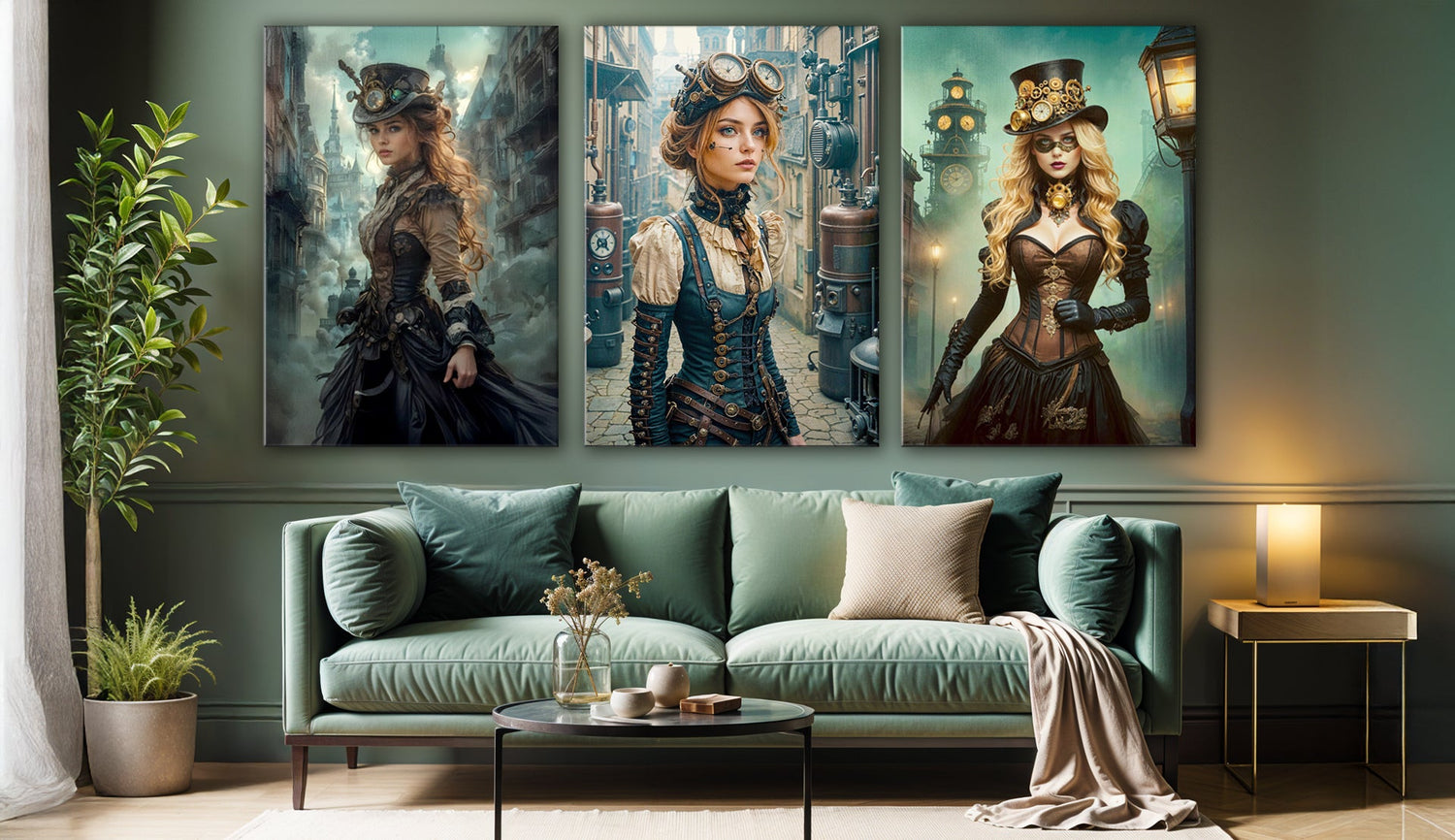
When Color Takes the Lead: A Trio of Acrylic Prints That Redefine a Room
Walk into a room that has been carefully furnished but left bare on the walls, and you may feel something is missing. It’s not always obvious what—sometimes it is a lack of warmth, sometimes a sense that the room has not quite found its voice. Art, when chosen well, can provide that voice. The trio of acrylic prints known as Colorful Countryside, Painted Flower, and Rainbow Cat suggests that walls do not need to whisper; they can speak clearly, even boldly, without apology.
Three Different Worlds, One Collection
Placed together, these prints form a set that doesn’t match in the conventional sense, but that is precisely what gives them energy. The Colorful Countryside transforms a rural scene into something bordering on the surreal, its sky swelling with purples, oranges, and greens. The Painted Flower is very colorful and curvy, like waves of paint. The Rainbow Cat, on the other hand, brings intimacy. Its fur ripples with color as it bends down to drink.
There will be some who find the combination unusual—why place a farm landscape beside an abstract bloom and a prismatic cat? Yet that unpredictability seems to be the point. Rather than three variations of a single theme, the set offers three distinct moods: grandeur, intensity, and play.
The Role of Acrylic in Their Impact
Mediums alter perception. Canvas softens edges, and paper absorbs, while acrylic sharpens. Its glass-like surface can be divisive—those who dislike reflections may find it too glossy—but for works built on color, it often heightens the effect. Light strikes, scatters, and deepens, so that the flower seems to curl outward, the countryside sky glows more than it should, and the cat’s fur feels almost tactile.
Beyond aesthetics, acrylic carries practical advantages. It resists fading and humidity, making it plausible for bathrooms or kitchens, not just bedrooms or living rooms. Of course, durability is not the reason most people choose art, but it matters when the intention is to keep pieces not for months but for years.
How They Shape Different Rooms
Every print alters space in a different way. In a living room, the countryside scene provides scale, offering a horizon line where otherwise there might be only furniture. In a bedroom, the flower’s curling forms might echo softness, its motion balancing the calm of fabric and light. The cat, with its curious and slightly humorous presence, could settle comfortably in a child’s room or on the wall of an office where too much seriousness needs breaking.
It is not that each work must always stand alone. Together they expand the atmosphere of a room, balancing each other the way a good conversation balances voices—sometimes solemn, sometimes vivid, sometimes lighthearted.

Beyond the Straight Line
The temptation is always to hang sets in a neat row. It’s safe, it looks balanced, and it rarely fails. But it can also flatten individuality. This trio invites more experimental arrangements. A vertical column along a tall wall changes perspective, guiding the eye upward. A diagonal across a hallway introduces movement, as though the images were in transit. Separating them into different rooms creates a slower reveal, letting the home itself carry the narrative.
When art is allowed to move away from symmetry, it tends to feel less like decoration and more like presence.
A Small Story of Change
Picture a neutral dining room: an polished oak table, chairs tucked neatly, and pale paint on the walls. The room is orderly but uninspired. One evening, the Painted Flower is hung above the sideboard. Suddenly, mealtimes shift. Light falls across the print, and its waves of color expand outward. This changes the conversation. Guests stop, fork in the air, and talk about the flower. The food is the same, the lighting unchanged, but the room feels altered. That is how artwork, even a single piece, can ripple into daily experience.
Where They Might Not Fit
It would be dishonest to suggest that this trio works everywhere. Those who like minimalism may find the colors too bright, the flower too big, and the cat too silly. The countryside print, with its swirling storm, might look too strange for spaces that are built to be simple. And yet, what feels excessive to one eye can feel exhilarating to another.
This is what makes the set interesting: it is not designed to blend politely into the background. It is more likely to stand its ground, and whether that is welcome depends on the taste of the viewer.
The Value of the Collection
Owning the set is less about uniformity than it is about range. The countryside offers breadth, the flower intensity, and the cat intimacy. Together they trace different ways of seeing, and that interplay makes them feel more like a collection than three unrelated prints. It is not just that the wall appears filled, but that the room itself acquires dimension.
Closing Reflection
A home becomes memorable not simply through what it contains, but through what it suggests. The Colorful Countryside, Painted Flower, and Rainbow Cat do not settle for subtlety. They aim higher, asking for attention and offering, in return, energy. They may not suit every room, but in the right one, they may change more than how the wall looks. They may change how the space feels and, by extension, how it is lived in.







